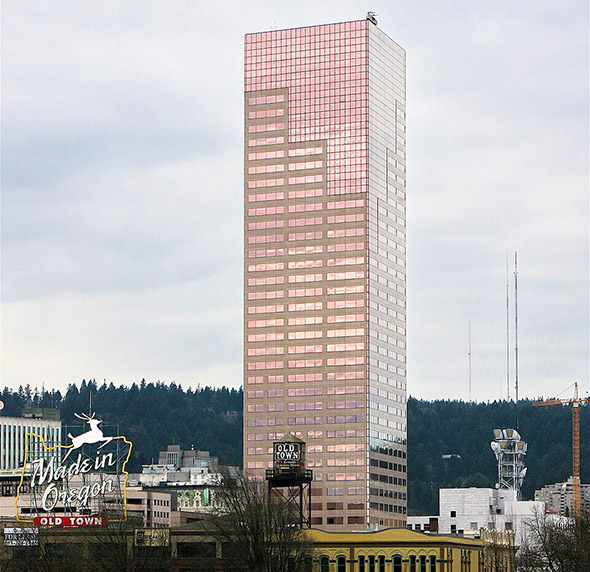The Wall Street Journal reported on May 20 that “Big Pink,” the 42-story pink skyscraper in downtown Portland (photo below) had been offered for sale for a price 80% below what the present owners paid for the building ten years ago.

U.S. Bancorp Tower, a.k.a. "Big Pink" in Portland, Oregon. Source: Cacophony, via Wikimedia under CC 3.0 License.
The Journal repeated criticisms of downtown Portland in an article entitled “A Fire Sale of Portland’s Largest Office Tower Shows How Far the City Has Fallen,” with the following subtitle: “The once-premier building is now over half empty, reflecting how the Oregon city’s downtown is struggling with crime and other quality-of-life issues.”
The Journal reported that downtown Portland has the highest office vacancy rate of any of the nation’s 25 largest central business districts. Former tenant Digital Trends said that it left because the building was afflicted with “vagrants sleeping in hallways of vacant office floors” and that they were “starting fires in stairwells, smoking fentanyl and defecating in common areas” These allegations were contained in the Digital Trends lease termination lawsuit.
Digital Trends’ added that Big Pink became a “cesspool of criminal activity and vandalism.”
Big Pink had been built for US National Bank four decades ago. US National is in the process of leaving the building. The Journal article noted that a number of firms have moved out of Portland, which before the pandemic was considered to be among the most favored of cities among urban planners.
New Portland Mayor Keith Wilson is considered to be pro-business. Downtown newspaper, Willamette Week reported that the Mayor responded in an email to constituents: “I wish they’d covered our rapid improvements in public safety, new residents, business opportunities, regional destinations, and creatives,” Wilson wrote. “Instead, they focused on the upcoming sale of ‘Big Pink,’ an iconic part of the Portland skyline, and a business tenant who left over safety and livability concerns.”
The Mayor (who was not Mayor when the problems were the worst) is right to be concerned. Restoring a reputation for central city safety is difficult, as decades of less than desirable results have shown around the country. We wish him well.
Wendell Cox is principal of Demographia, an international public policy firm located in the St. Louis metropolitan area. He is a Senior Fellow with Unleash Prosperity in Washington and the Frontier Centre for Public Policy in Winnipeg and a member of the Advisory Board of the Center for Demographics and Policy at Chapman University in Orange, California. He has served as a visiting professor at the Conservatoire National des Arts et Metiers in Paris. His principal interests are economics, poverty alleviation, demographics, urban policy and transport. He is author of the annual Demographia International Housing Affordability Survey and author of Demographia World Urban Areas.
Mayor Tom Bradley appointed him to three terms on the Los Angeles County Transportation Commission (1977-1985), which was a predecessor agency to the Los Angeles County Metropolitan Transportation Authority (Metro). Speaker of the House Newt Gingrich appointed him to the Amtrak Reform Council, to complete the unexpired term of New Jersey Governor Christine Todd Whitman (1999-2002). He is author of War on the Dream: How Anti-Sprawl Policy Threatens the Quality of Life and Toward More Prosperous Cities: A Framing Essay on Urban Areas, Transport, Planning and the Dimensions of Sustainability.












